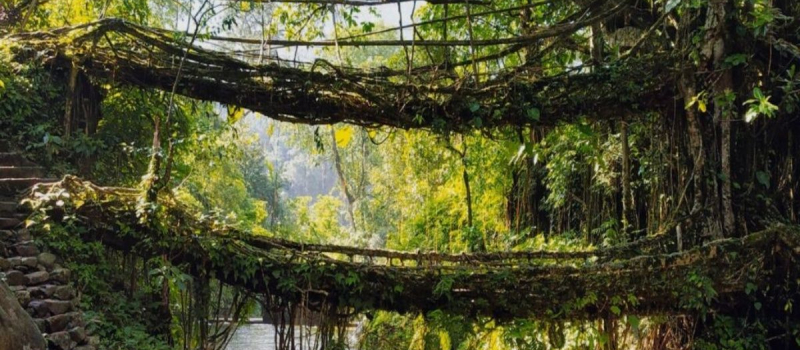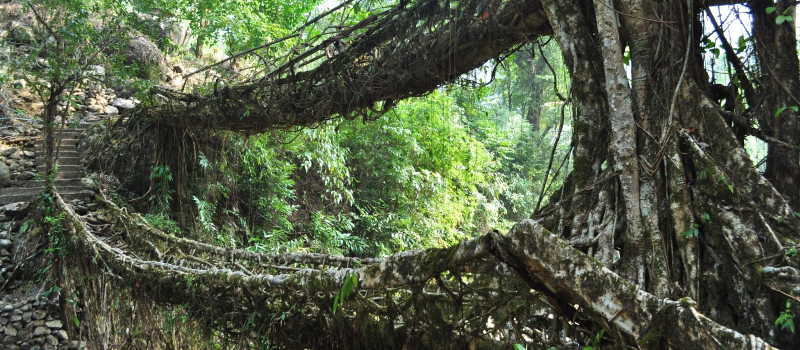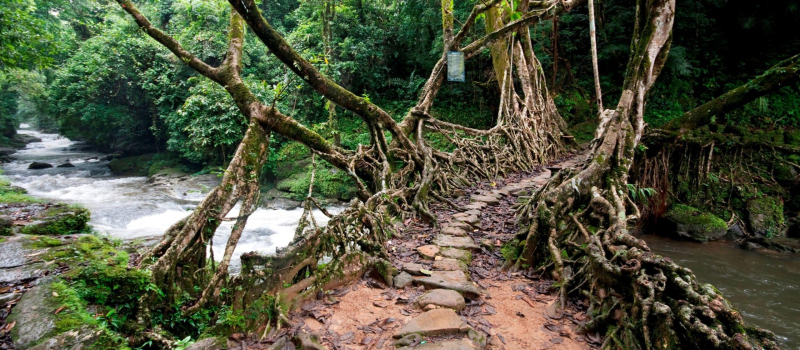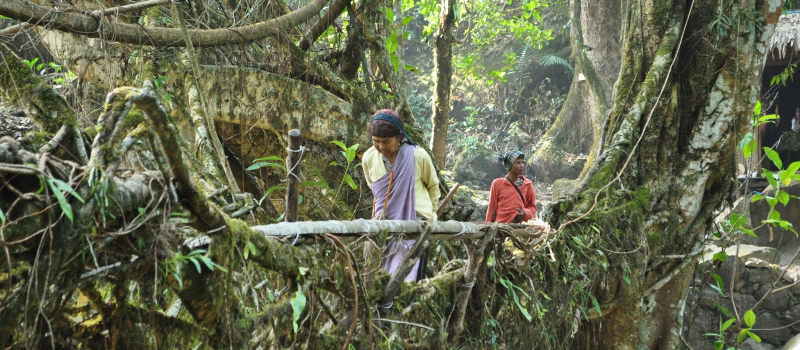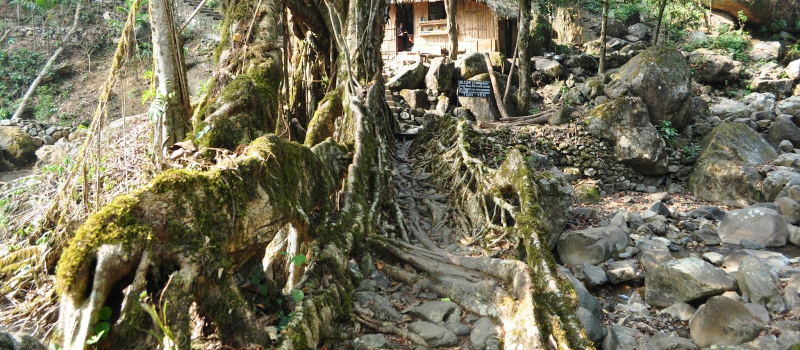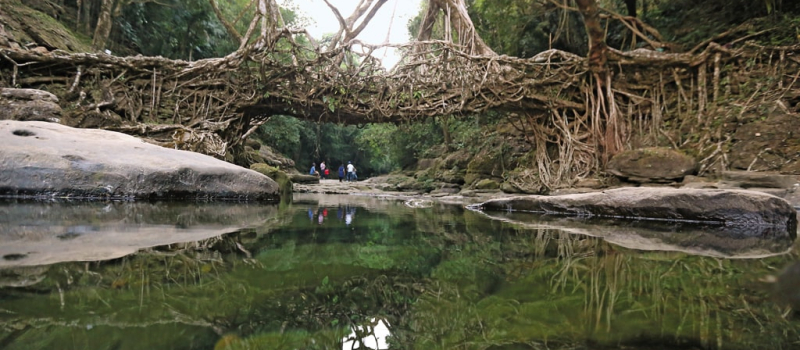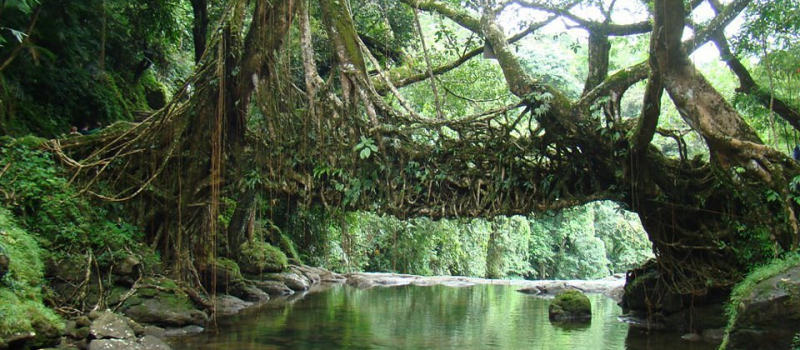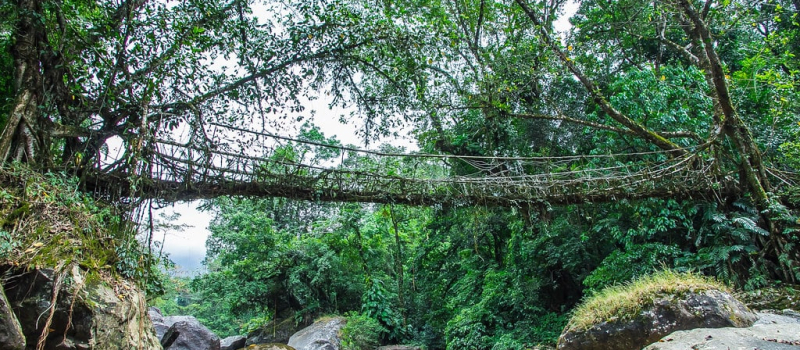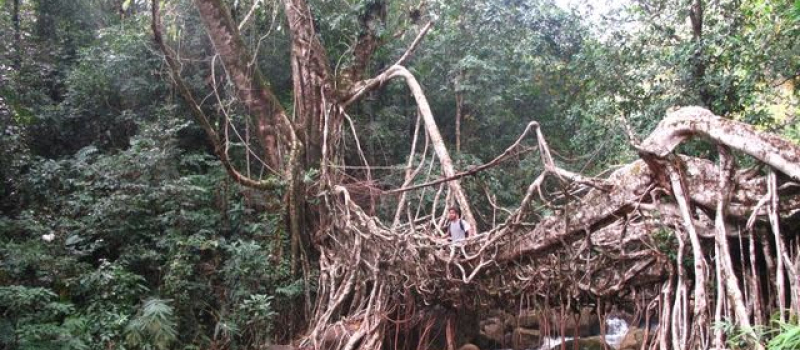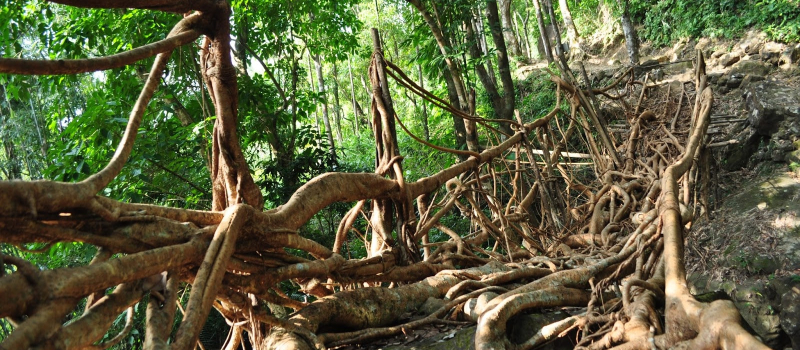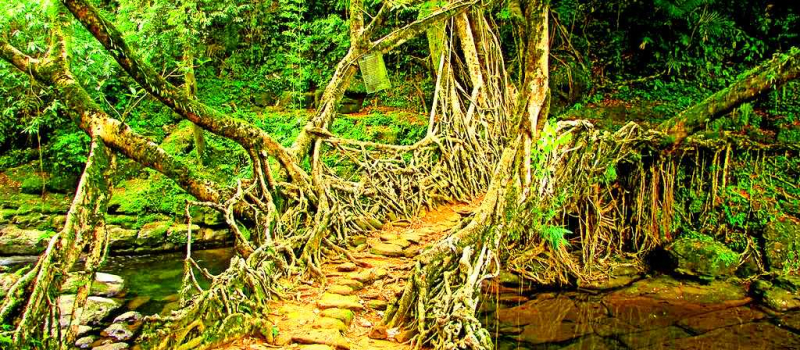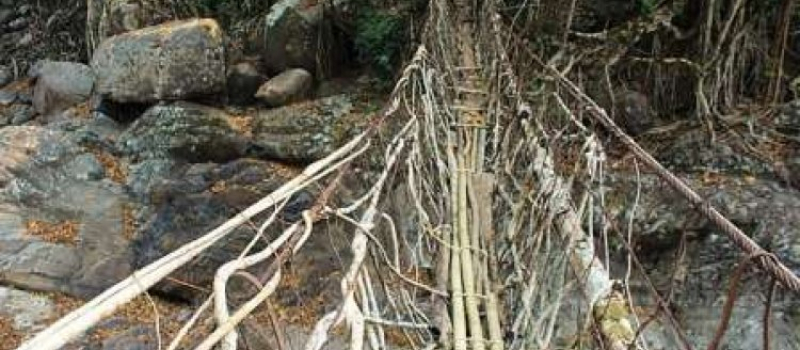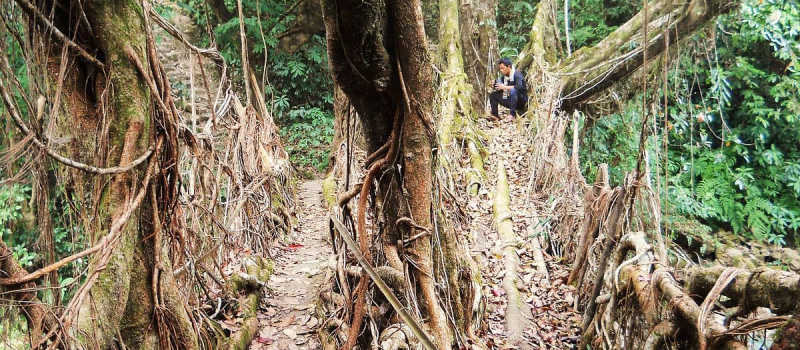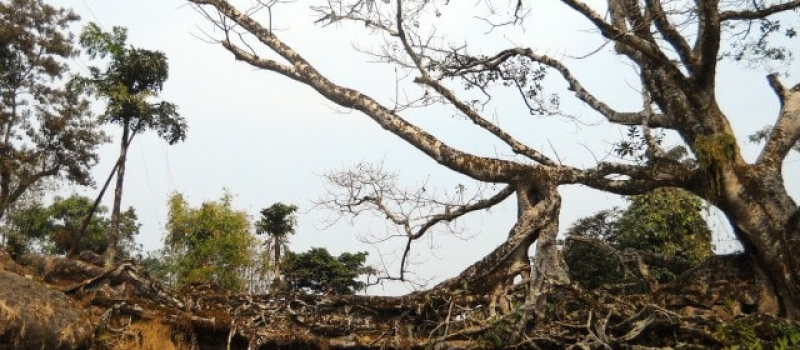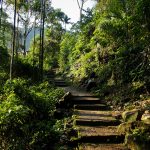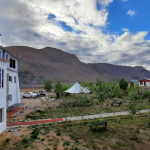Top 10 Living Root Bridges of Meghalaya for Natural Retreat
Nestled in the enchanting hills of Northeast India, Meghalaya is a captivating state that beckons travelers with its breathtaking landscapes, vibrant culture, and delectable cuisine. Known as the “Abode of Clouds,” the natural charm of Meghalaya sets it apart from other tourist destinations. The state is home to diverse indigenous communities, each with its distinct traditions, adding to the rich cultural tapestry of the region.
Meghalaya’s cuisine is a delightful blend of flavors, reflecting the agricultural abundance and cultural heritage of the state. Local delicacies like Jadoh (a rice and meat dish), Nakham Bitchi (dried fish chutney), and Dohneiihong (pork with black sesame) tantalize the taste buds with their authentic taste. The traditional preparation methods and the use of fresh ingredients sourced from the region’s fertile lands make Meghalayan cuisine a gastronomic adventure.
While Meghalaya’s natural beauty is captivating, its most extraordinary attractions are the living root bridges. These marvels of sustainable engineering are unique to the region and showcase the harmonious relationship between nature and human ingenuity. These bridges are created by guiding the aerial roots of rubber fig trees across streams and rivers until they form a robust and intricate network of interwoven roots.
Cherrapunji and Nongriat villages in Meghalaya are particularly famous for their living root bridges. These bridges not only provide functional pathways for the locals to traverse the rugged terrain but also serve as mesmerizing architectural wonders that have garnered international acclaim.
Tourists can embark on a memorable trek through lush green forests, crossing these bridges suspended above gushing waterfalls and emerald pools. These root bridges in Meghalaya exemplify the indigenous knowledge and sustainable practices of the local Khasi and Jaintia tribes.
These bridges, often centuries-old, are a testament to the deep-rooted bond between the people and their natural surroundings. Recognizing their cultural and ecological significance, efforts are underway to seek UNESCO World Heritage status for these living root bridges, further highlighting their global importance.
For nature enthusiasts, adventurers, and cultural explorers, the living root bridges in Meghalaya is a perfect place to connect with nature and thus are a highlight of our Meghalaya Holiday Packages. As you traverse these organic structures, witnessing the interplay of nature and human craftsmanship, you are bound to be enchanted by the sheer beauty and ingenuity that Meghalaya holds within its verdant embrace.
Legends of the Living Root Bridges of Meghalaya
In the verdant hills of Meghalaya, a remarkable feat of human innovation and nature’s resilience has given rise to captivating living root bridges. These awe-inspiring structures are steeped in legends, shaped by history, and hold immense cultural and ecological significance.
The origins of the living root bridges in Meghalaya can be traced back centuries, with their creation attributed to the indigenous Khasi and Jaintia tribes. The exact timeline of their construction is unclear, but it is believed that the practice began around 500 years ago. The ingenious idea behind these bridges was to harness the growth potential of the Ficus elastica, a rubber fig tree with robust aerial roots that could be trained and guided to form stable bridges across streams and rivers.
Legends passed down through generations explain that the knowledge of creating these bridges was imparted by a benevolent spirit known as “U Rymbai.” According to folklore, U Rymbai revealed the technique to a Khasi tribe member in a dream. Inspired by the vision, the villagers began cultivating the roots of these fig trees, shaping them over time into living bridges that could withstand the forces of nature.
Another legend tells of a Khasi tribe member named Lajong, who discovered a magical vine while wandering through the dense forests of Meghalaya. This vine possessed supernatural qualities that allowed it to grow and stretch, defying the limitations of conventional plants. Fascinated by this extraordinary find, Lajong sought the advice of a local soothsayer.
The soothsayer, known for her deep connection with nature and the spirits that dwell within it, revealed the true potential of the vine to Lajong. She explained that by carefully guiding the roots of the vine across the watercourses, they could be trained to form living bridges, strong enough to withstand the passage of time and the forces of nature.
Inspired by this knowledge, Lajong returned to his village and shared the secret with his fellow villagers. They began the task of cultivating the vines and shaping them into intricate bridge structures. With patience and perseverance, the villagers witnessed the miraculous transformation of the vines into living root bridges, steadily growing and intertwining to form stable and durable pathways.
The legend further narrates that the root bridges were not only functional bridges but also imbued with a magical quality. It is believed that the bridges possessed healing properties, and those who walked across them would experience rejuvenation and a sense of well-being. The bridges were considered sacred, serving as a link between the earthly realm and the spiritual realm, connecting humans with the mystical forces of nature.
Today, these root bridges continue to inspire awe and wonder, captivating visitors from around the world. They stand as a testament to the ancient wisdom of the Khasi people, their harmonious relationship with nature, and their innovative approach to sustainable engineering.
While the legends associated with these root bridges may be steeped in folklore and myth, they contribute to the allure and cultural significance of these extraordinary structures. As travelers explore the enchanting landscapes of Meghalaya and walk across these living bridges, they are invited to immerse themselves in the legends, experiencing a connection to the rich tapestry of stories that have shaped the region’s identity for generations.
Also Read: The Best Of Meghalaya: 10 Best Things To Do In Meghalaya
Significance of the living root bridges of Meghalaya
The living root bridges hold immense practical significance for the local communities, serving as essential transportation arteries in the hilly terrain of Meghalaya. They provide safe passage during monsoon seasons when rivers swell, and conventional bridges may be washed away. Moreover, they serve as sustainable alternatives to wooden or steel bridges that require regular maintenance and replacement.
Beyond their utilitarian value, the living root bridges have become symbols of cultural identity and pride for the people of Meghalaya. They exemplify the harmonious coexistence between humans and nature, showcasing the wisdom and resourcefulness of the indigenous communities. The bridges represent a deep-rooted connection to the land, traditions, and ancestral wisdom that have sustained the region for centuries.
In recent years, the living root bridges in Meghalaya have gained international recognition for their unique beauty and sustainable engineering. Efforts are underway to seek UNESCO World Heritage status for these bridges, aiming to preserve and promote their cultural and ecological significance on a global platform.
Visiting these living root bridges is a truly immersive experience, allowing travelers to witness the remarkable synergy between humans and nature. As you traverse these living, breathing structures, surrounded by lush greenery and the sounds of cascading waterfalls, you become part of a timeless narrative that celebrates the resilience of traditional wisdom and the enchanting wonders of Meghalaya’s natural landscape.
Process of Creating the living root bridges in Meghalaya
The process of constructing a living root bridge is labor-intensive and requires patience and expertise. It demonstrates the indigenous communities’ deep understanding of nature and their sustainable engineering practices. Villagers carefully guide the aerial roots across the watercourse, allowing them to grow and intertwine with precision.
Over the years, the roots mature and strengthen, gradually transforming into sturdy and durable bridge structures. These bridges are living organisms, constantly adapting and reinforcing themselves as new roots sprout and intertwine with the existing network. The creation and maintenance of living root bridges in Meghalaya begin by planting two rubber fig trees on the opposite banks of the water body and further waiting for them to grow into sturdy trees with roots. The next part of the process involves the following methods:
Guided Root Method – This is the most common method used to create living root bridges. It involves guiding the aerial roots of rubber fig trees (Ficus elastica) across a watercourse. Villagers carefully nurture and train the roots by using betel nut trunks, bamboo scaffolding, or stones to direct their growth. Over time, the roots grow thicker and stronger, gradually forming a network of interwoven roots that can support the weight of people crossing the bridge.
Hollowed Trunk Method – In some cases, hollowed trunks of betel nut or other similar trees are used as natural tunnels to guide the roots across the water. The roots are directed through the hollowed trunks until they reach the opposite bank. Once they establish contact with the ground, they grow and spread, eventually forming a living root bridge.
Reinforced Platform Method – To create larger and more stable bridges, the roots are trained and guided to grow on a reinforced platform made of stones or wooden planks. This method provides a solid foundation and additional support for the growing roots. The platform allows the roots to fuse with the added structure, resulting in a more robust and long-lasting bridge. Maintenance of these bridges is a communal effort carried out by the local communities who consider it a collective responsibility. Some of the methods used for maintenance include:
Regular Root Pruning – To maintain the structural integrity of the bridges, the aerial roots are pruned regularly. By removing excess growth and dead roots, the locals ensure that the bridge remains strong and functional.
Addition of Secondary and Tertiary Roots – The locals guide the secondary and tertiary roots to grow and intertwine with the existing root network. This process helps strengthen the bridge over time and reinforces any weak areas.
Replacement and Repair – In cases where a section of the living root bridge is damaged or weakened due to natural factors such as heavy rainfall or erosion, the locals repair or replace the affected portion. This involves carefully redirecting new roots to form connections and allowing them to mature and grow.
Famous Living Root Bridges in Meghalaya
While there are several living root bridges in Meghalaya, the famous ones are listed below:
1. Umshiang Root Bridge – The Double-Decker Root Bridge in Cherrapunji
The Umshiang Root Bridge, also known as the Double Decker Root Bridge, is one of the most famous ones because of its unique double-decker structure, where two separate layers of living roots intertwine to form a sturdy bridge. It is located in the village of Nongriat, near Cherrapunji. To reach the Double-Decker Root Bridge in Cherrapunji, you can start your trek from Tyrna village, which is approximately 85 kilometers from Shillong. From Tyrna, you need to trek downhill for about 3-4 hours through a scenic trail comprising around 3,000 steps.
2. Mawsaw Root Bridge
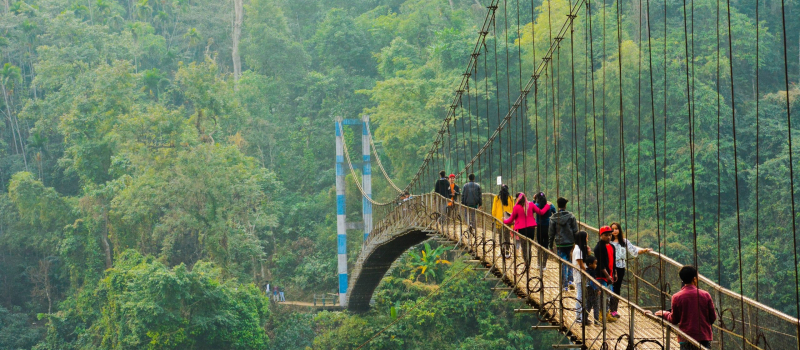
The Mawsaw Root Bridge is situated in the village of Riwai, near Mawlynnong. It is a single-decker root bridge in Shillong and is known for its beautiful location amidst lush green surroundings. To reach Mawsaw Root Bridge, you can drive approximately 90 kilometers from Shillong to Mawlynnong village. From the village entrance, it is a short walk to the bridge.
3. Mawlynnong Root Bridge
The Mawlynnong Root Bridge is located in the cleanest village in Asia, Mawlynnong. It is a single-decker living root bridge that showcases the unique engineering skills of the local Khasi tribes. To reach Mawlynnong Root Bridge, you can drive approximately 90 kilometers from Shillong to Mawlynnong village. The bridge is easily accessible from the village center.
4. Rittymmen Root Bridge
Located in the village of Nongthymmai, the Rittymmen Root Bridge is another single-decker root bridge in Shillong. It is a popular attraction known for its impressive structure formed by the interconnected roots of ancient trees. To reach Rittymmen Root Bridge, you can hire a taxi or drive approximately 45 kilometers from Shillong to Nongthymmai village. The bridge is easily accessible from the village.
5. Ummunoi Root Bridge
The Ummunoi Root Bridge is situated in the village of Umkar, near the town of Dawki. This single-decker living root bridge is known for its simplicity and natural beauty. To reach Ummunoi Root Bridge, you can drive approximately 82 kilometers from Shillong to Dawki. From Dawki, it is a short distance to Umkar village, where you can find the bridge.
6. Umkar Root Bridge
Umkar Root Bridge is another significant living root bridge located in the village of Umkar. It is a single-decker bridge known for its strength and durability. To reach Umkar Root Bridge, you can follow the same route as Ummunoi Root Bridge, driving approximately 82 kilometers from Shillong to Dawki and then reaching Umkar village.
7. Living Root Bridge at Shnongpdeng
The Living Root Bridge at Shnongpdeng is situated in the village of Shnongpdeng, known for its pristine riverside location and adventure activities. It is a single-decker root bridge that provides a picturesque backdrop for visitors. To reach Shnongpdeng, you can drive approximately 95 kilometers from Shillong. The bridge is located near the village and can be reached by a short walk.
8. Kudeng Thymmai and Kudeng Rim Bridge
Kudeng Thymmai and Kudeng Rim Bridge are two living root bridges located in the village of Nongriat. They are single-decker bridges known for their intricate root formations. To reach Kudeng Thymmai and Kudeng Rim Bridge, you can start your trek from Tyrna village, approximately 85 kilometers from Shillong, and follow the trail to Nongriat village.
9. Padu Bridge
The Padu Bridge is located in the village of Padu, near Mawlynnong. It is a single-decker living root bridge that offers a unique experience to visitors. To reach Padu Bridge, you can drive approximately 90 kilometers from Shillong to Mawlynnong village. From there, it is a short distance to Padu village and the bridge.
10. Nongbareh Living Root Bridge
The Nongbareh Living Root Bridge is situated in the village of Nongbareh, near Mawlynnong. It is a single-decker root bridge that showcases the natural engineering skills of the local community. To reach Nongbareh Living Root Bridge, you can drive approximately 90 kilometers from Shillong to Mawlynnong village. From Mawlynnong, it is a short distance to Nongbareh village and the bridge.
It is recommended to hire local guides or join organized tours to ensure a safe and informative visit to these famous living root bridges. They can provide detailed directions and insights into the bridges’ history, local culture, and natural surroundings.
Also Read: 10 Waterfalls In Meghalaya To Visit On Your Next Trip
Frequently Asked Questions About Living Root Bridges In Meghalaya
1. What are living root bridges?
Living root bridges are unique natural structures found in Meghalaya, India, where the roots of Ficus elastica trees(rubber fig trees) are trained and manipulated to form living bridges over rivers and streams. The Khasi and Jaintia tribes of Meghalaya have been practicing this ancient technique for centuries, creating durable and flexible bridges that can withstand heavy rainfall and flooding. The roots are guided and shaped by the locals over several decades until they form a strong and functional bridge, which continues to grow and strengthen over time.
2. Where can I find living root bridges in Meghalaya?
Meghalaya is home to several living root bridges, with some of the famous ones located in different villages. The popular destinations to find these bridges include the villages of Nongriat, Mawlynnong, Dawki, Riwai, and Shnongpdeng. Each village offers a unique experience and a chance to witness the remarkable craftsmanship of the local communities. These villages are located in scenic locations amidst the lush greenery of Meghalaya’s forests.
3. Are living root bridges safe to walk on?
Living root bridges are generally safe to walk on, as they are designed to be strong and sturdy. However, it’s important to exercise caution and follow any guidelines provided by local guides or authorities. Some bridges may have a limited weight-bearing capacity, so it’s advisable to avoid overcrowding or putting excessive weight on the bridges. It’s also recommended to wear appropriate footwear and take care while crossing the bridges, especially during rainy or slippery conditions.
4. Can I visit the living root bridges year-round?
Yes, you can visit the living root bridges in Meghalaya year-round. However, it’s important to note that Meghalaya experiences heavy rainfall during the monsoon season, which can make the trails and bridges slippery and challenging to navigate. The best time to visit is during the dry months from November to April when the weather is more favorable for trekking and exploring. It’s always a good idea to check the local weather conditions and plan your visit accordingly.



